The Fertigation Control System Market is estimated to be valued at USD 1.4 billion in 2025 and is projected to reach USD 3.1 billion by 2035, registering a compound annual growth rate (CAGR) of 8.3% over the forecast period.
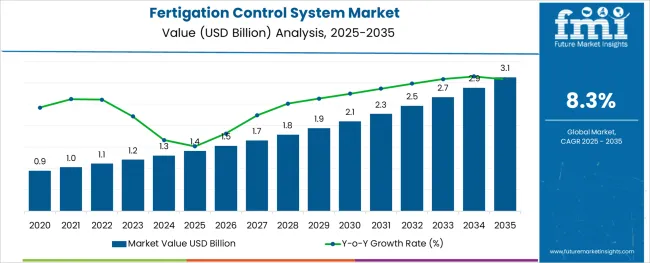
The fertigation control system market is experiencing steady growth driven by the increasing need for precision agriculture and resource efficiency. Rising concerns over water scarcity, soil health, and fertilizer overuse have led to wider adoption of controlled fertigation solutions across diverse agricultural practices.
Enhanced crop yields, reduced operational costs, and compliance with sustainability goals are motivating stakeholders to transition from traditional methods to automated, intelligent systems. Future growth is expected to be supported by technological innovations, government initiatives promoting sustainable farming, and the rising penetration of smart farming concepts.
The integration of IoT, data analytics, and advanced sensors is paving the way for higher efficiency, greater crop quality, and improved resource utilization, thereby creating long-term opportunities for this market.
The market is segmented by Channel, Technology, and End Use and region. By Channel, the market is divided into Multi, Single, and Dual. In terms of Technology, the market is classified into Automated and Manual. Based on End Use, the market is segmented into Greenhouse, Open Field, Research Body, and Others. Regionally, the market is classified into North America, Latin America, Western Europe, Eastern Europe, Balkan & Baltic Countries, Russia & Belarus, Central Asia, East Asia, South Asia & Pacific, and the Middle East & Africa.
The market is segmented by Channel, Technology, and End Use and region. By Channel, the market is divided into Multi, Single, and Dual. In terms of Technology, the market is classified into Automated and Manual. Based on End Use, the market is segmented into Greenhouse, Open Field, Research Body, and Others. Regionally, the market is classified into North America, Latin America, Western Europe, Eastern Europe, Balkan & Baltic Countries, Russia & Belarus, Central Asia, East Asia, South Asia & Pacific, and the Middle East & Africa.
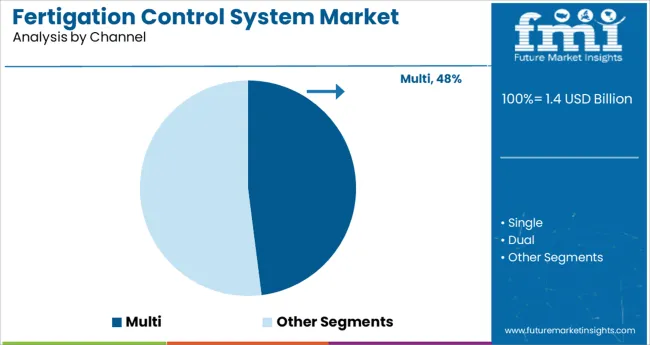
When segmented by channel the multi segment is projected to hold 48% of the market revenue in 2025 making it the leading channel. This dominance has been attributed to its ability to simultaneously manage the distribution of nutrients and water across multiple zones ensuring uniformity and efficiency in large-scale operations.
Its flexible configuration and scalability have made it suitable for diverse crop patterns and varying field conditions. Multi channel systems have enabled growers to optimize resource allocation reduce wastage and enhance productivity by catering to site-specific needs within the same farm.
Increased awareness of the benefits of zoning and the demand for higher precision in nutrient delivery have further reinforced the preference for multi channel configurations in commercial farming setups.
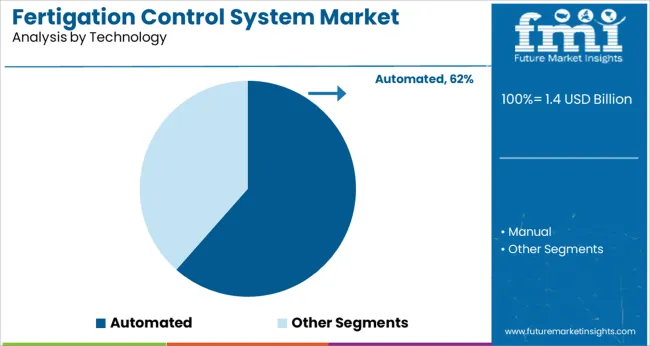
In terms of technology the automated segment is expected to capture 61.5% of the market revenue in 2025 solidifying its position as the dominant technology segment. The preference for automated systems has been driven by the need for consistent precise and timely nutrient delivery which minimizes human error and enhances crop outcomes.
Automated technology has enabled growers to monitor and adjust fertigation parameters remotely ensuring optimal soil moisture and nutrient levels even under changing environmental conditions. The reduction in labor dependency along with higher operational efficiency has made automated solutions particularly attractive for large-scale and high-value crop producers.
Additionally the integration of sensors and software for real-time data analysis has elevated the reliability and effectiveness of these systems supporting their widespread adoption.
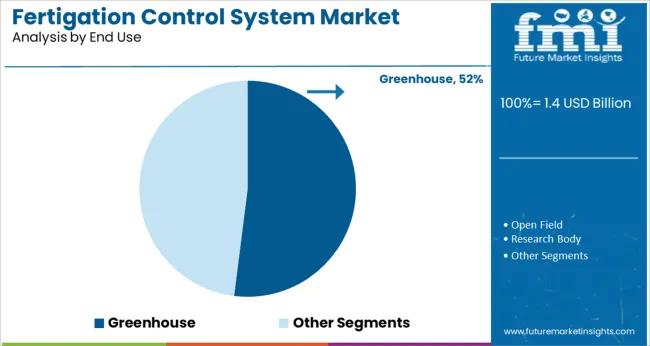
Segmented by end use the greenhouse segment is anticipated to account for 52% of the market revenue in 2025 securing its leadership among end users. The controlled environment of greenhouses has aligned well with fertigation systems as growers aim to maximize yields within limited spaces and minimize external variability.
Greenhouses have increasingly relied on fertigation to deliver precise nutrient mixes tailored to specific crops enhancing quality and consistency. The ability of fertigation systems to support intensive cultivation and reduce resource waste has strengthened their adoption in greenhouse operations.
Rising investments in protected cultivation and the focus on year-round production have further propelled the greenhouse segment to the forefront of the market. The synergy between controlled environments and precision fertigation has reinforced its position as the preferred end use segment.
Short-term Growth: Between 2020 and 2025, the global fertigation control system market expanded at a lower CAGR of over 3.6 %. Different types of fertilizer applications are commercially available. This is due to the need for better crop yield and production. Moreover, investments have increased over time, and this has led to the adoption of fertigation systems for greenhouse cultivation.
Mid-term Growth: In terms of pricing, the level of output channels involved in an individual system is considered to be the key determinant. The system pricing is understood to be between USD 650 for uni-channel to the extent of USD 8,000 per unit for multichannel systems. Through these factors, the market will reach a value of USD 3.1 Billion by 2035.
Long-term Growth: Retail channel pricing is the common mode undertaken by the equipment manufacturers to provide the end users with the said equipment. Future Market Insights forecasts the global fertigation control system market to expand at over 8.3 % CAGR through 2035, along with a value of USD 2.6 Billion.
The trend of customization has had an impact on the growth of the fertigation control system market in recent years. Controlled environment agriculture (CEA), vertical farming, indoor urbanized farming, and hydroponic growing methods have all seen increased acceptance, providing market participants with more opportunities to supply customized services and solutions.
The initial installation cost associated with the fertigation control systems is one of the prominent challenges to market growth. Also, experts are required for the installation and for the efficient operation of the system.
Therefore, technical support should be pursued in order to achieve desired results whenever required. Moreover, fertilizers in tanks frequently cause corrosion in the metal components of the system. This problem can be abolished with the use of corrosion-resistant materials, especially in fertilizer tanks and other equipment that comes into contact with fertilizer.
Fertigation control systems have a number of advantages, including the ability to adjust the nutrient requirements of crops in order to maximize their growth. For instance, numerous players are selling fertigation control systems that can regulate chemical dosing to maintain proper pH values and other soil factors that are essential for plant growth.
Dosing of nutrients in irrigation water to maintain a diluted nutrient solution is also possible with fertigation control systems. Fertigation control systems are a cost-effective option for reducing requirements of labor, nutrient volume, and dosing.
| Regions | Absolute Market Growth |
|---|---|
| USA | 230.8 Million |
| UK | 70.9 Million |
| China | 133.5 Million |
| Japan | 69.6 Million |
| South Korea | 39.6 Million |
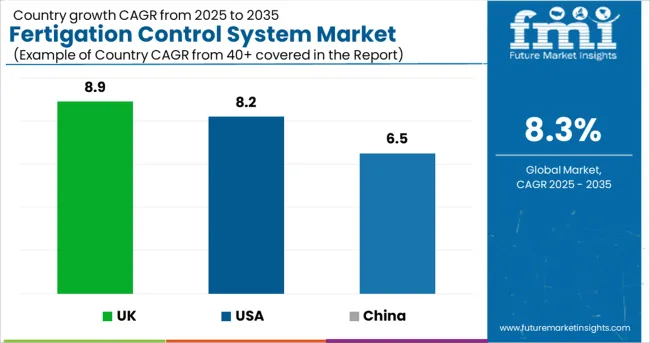
Expansion of USA agricultural lands along with the advanced farming methods implemented in the system are likely to propel the growth.
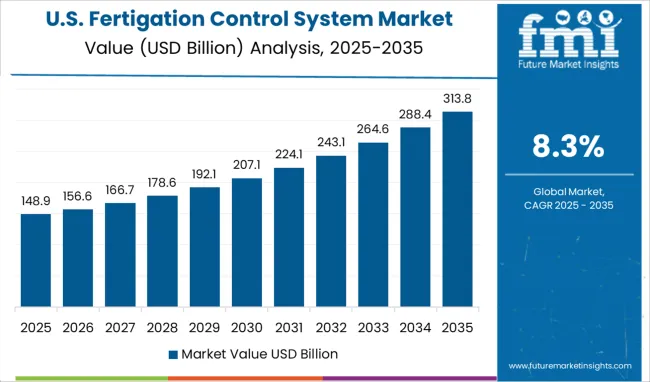
| Region | Attributes |
|---|---|
| USA Market CAGR (2025 to 2035) | 8.2% |
| USA Market Absolute Doller Growth (million/Billion) | USD 230.8 million |
The USA market is expected to register a CAGR of 8.2% from 2025 to 2035. In the USA, fertigation control systems have been installed throughout the country in the advanced agriculture sector. The market is set to reach an anticipated value of 3.1 Million by 2035.
Automated fertigation control systems are gaining traction in the USA market. New trends in the fertigation management applications of irrigated vegetable crops are becoming common in the country, creating a conducive environment for long-term growth. This factor makes the USA the biggest market for fertigation control systems.
The higher government investments in the Research and Development of fertigation procedures have led to the adoption of control methods.
| Region | Attributes |
|---|---|
| UK Market CAGR (2025 to 2035) | 8.9% |
| UK Market Absolute Doller Growth (million/Billion) | USD 70.9 Million |
The United Kingdom witnessed an increase in the share of the agricultural economy in its states. The government spending on agricultural workshops around advanced systems such as control methods and organic farming has led farmers to adopt them.
Thus, easy irrigation mapping and implementation have led to the rising sales of fertigation control systems. Furthermore, the fixation of mistakes done post-green revolution has been fixed with fertigation as it has mellowed down the side effects of fertilizers while improving crop health. The market in the UK is likely to reach a value of USD 123.4 Million by 2035.
Transformative policies of Chinese Governments fuel the adoption of Fertigation Control Systems.
| Region | Attributes |
|---|---|
| Chinese Market CAGR (2025 to 2035) | 6.5% |
| Chinese Market Absolute Doller Growth (million/Billion) | USD 133.5 Million |
The fertigation control system market in China is expected to reach a value of USD 284.7 Million by 2035. The country is a large producer, consumer, and trader of equipment related to farming and agriculture.
Innovations in agricultural operations, mainly to support new agricultural business entities, social, agricultural production services, cultivation plans for competent farmers, and agricultural credit guarantees, are being boosted through government regulations.
However, the sales of the automatic control field of fertigation in the country are low compared to the USA The trade war is expected to have a moderate adverse impact on the market in the short term.
According to the study, the fertigation control system market in Spain is expected to account for a major share of 19.4% in Europe from 2025 to 2035. In European countries, the cultivation of fertigated crops frequently suffers from a scarcity of water, which affects the yield of cultivation.
In Spain, drip irrigation system technologies have been installed extensively by water users’ associations. The infrastructure of centralized fertigation has been adopted by most of the country in agricultural areas to reduce additional labor costs.
Due to increasing awareness about smart agriculture solutions over traditional practices in India, the market is projected to rise with a growth rate of 8.5% between 2024-2035. The application of fertigation control systems in arid and semi-arid regions is becoming popular in India.
India is one of the top countries in the production of sugarcane which adoption of the fertigation control system is proved to be a catalyst supporting sugarcane yield in addition to propelling the global fertigation control system market.
According to the research, the fertigation control system market in Germany is expected to rise at a significant CAGR during the forecast period. Small-scale farming operations are raising the scope of commercial urban farming in many regions of Germany,
This has witnessed significant growth in recent years. Additionally, the adoption of urban farming and organic farming in developed countries of Europe is propelling the market growth of fertigation control systems.
| Segment | Top Channel |
|---|---|
| Top Sub-segment | Multi |
| CAGR (2020 to 2025) | 3.7% |
| CAGR (2025 to 2035) | 8.1% |
| Segment | Top Technology |
|---|---|
| Top Sub-segment | Automated |
| CAGR (2020 to 2025) | 3.5% |
| CAGR (2025 to 2035) | 7.8% |
Based on channel, the multi-channel fertigation control system is expected to register a CAGR of 8.1% over the forecast period from 2025 to 2035. Multi-channel systems are fully configurable, assist precision farming, and can be used for multiple crop fields.
With aid of digitalization, these systems are being incorporated with more advancements than ever before, while being readily adopted by end-users, in a vast intensive farming sector.
Based on technology, automated technology ensures superior crop results in comparison to conventional practices. It helps to improve the efficiency of micronutrient delivery to the crops. Additionally, automated control systems have sensors that measure the water level in the tank and its temperature.
Pump controls and irrigation valves can be controlled easily. The segment is expected to thrive at a CAGR of 7.8% by 2035, owing to higher application efficacy.
As the market is new, the key start-ups try to make a system that puts a cap on the fertigation procedure, tracking, monitoring, and flow. The advanced policies through government initiatives help start-ups get funding. Some of the major start-ups are:
The fertigation control system market includes a moderately consolidated competitive environment, where a majority of market players are focusing on strategic collaborations. Leading fertigation control system manufacturers are currently working on Research and Development efforts and new product launches to keep up with the rising product consumption in South Asia and East Asia.
Latest Developments
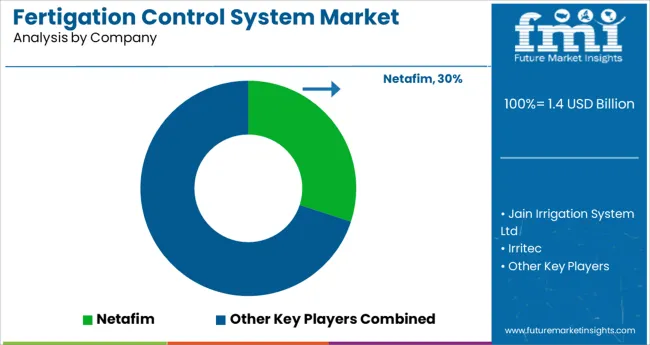
The global fertigation control system market is estimated to be valued at USD 1.4 billion in 2025.
It is projected to reach USD 3.1 billion by 2035.
The market is expected to grow at a 8.3% CAGR between 2025 and 2035.
The key product types are multi, single and dual.
automated segment is expected to dominate with a 61.5% industry share in 2025.






Full Research Suite comprises of:
Market outlook & trends analysis
Interviews & case studies
Strategic recommendations
Vendor profiles & capabilities analysis
5-year forecasts
8 regions and 60+ country-level data splits
Market segment data splits
12 months of continuous data updates
DELIVERED AS:
PDF EXCEL ONLINE
Fertigation Monitoring Market Size and Share Forecast Outlook 2025 to 2035
Remote Fertigation Monitoring Services Market
Controllable Shunt Reactor for UHV Market Size and Share Forecast Outlook 2025 to 2035
Control Room Solution Market Size and Share Forecast Outlook 2025 to 2035
Control Knobs for Panel Potentiometer Market Size and Share Forecast Outlook 2025 to 2035
Controlled-Release Drug Delivery Technology Market Size and Share Forecast Outlook 2025 to 2035
Controlled Environment Agriculture (CEA) Market Size and Share Forecast Outlook 2025 to 2035
Control Cable Market Size and Share Forecast Outlook 2025 to 2035
Control Towers Market Size and Share Forecast Outlook 2025 to 2035
Controlled & Slow Release Fertilizers Market 2025-2035
Controlled Intelligent Packaging Market
Biocontrol Solutions Market Size and Share Forecast Outlook 2025 to 2035
Biocontrol Agents Market Size and Share Forecast Outlook 2025 to 2035
Oil Control Shampoo Market Size and Share Forecast Outlook 2025 to 2035
LED Control Unit Market Size and Share Forecast Outlook 2025 to 2035
Sun Control Films Market Size and Share Forecast Outlook 2025 to 2035
CNC Controller Market Size and Share Forecast Outlook 2025 to 2035
PID Controller Market Size and Share Forecast Outlook 2025 to 2035
Market Share Breakdown of Sun Control Films Manufacturers
PLC Controlled Packing Machine Market Trends – Forecast 2024-2034

Thank you!
You will receive an email from our Business Development Manager. Please be sure to check your SPAM/JUNK folder too.
Chat With
MaRIA